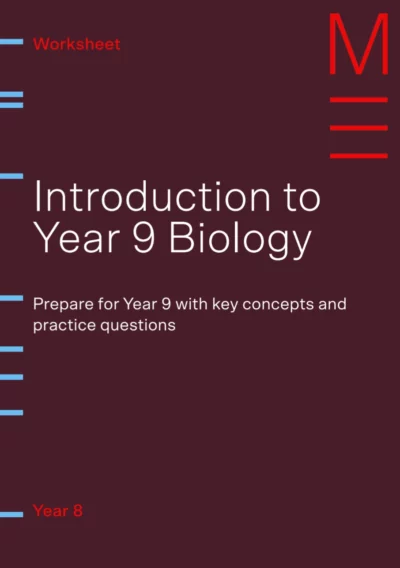In this article, we’ll explore the main topics you’ll cover in Year 9 Biology, and help you see if you’re ready for it!
Welcome to Matrix Education
To ensure we are showing you the most relevant content, please select your location below.
Select a year to see courses
Learn online or on-campus during the term or school holidays
Learn online or on-campus during the term or school holidays
Learn online or on-campus during the term or school holidays
Learn online or on-campus during the term or school holidays
Learn online or on-campus during the term or school holidays
Learn online or on-campus during the term or school holidays
Learn online or on-campus during the term or school holidays
Learn online or on-campus during the term or school holidays
Learn online or on-campus during the term or school holidays
Learn online or on-campus during the term or school holidays
Select a year to see available courses
Science guides to help you get ahead
Science guides to help you get ahead
Wondering if you're ready for Year 9 Biology? This quick guide will help you review key concepts and test your knowledge before diving in.

Join 75,893 students who already have a head start.
"*" indicates required fields
You might also like
Related courses

Join 8000+ students each term who already have a head start on their school academic journey.
In Year 9 Science, you’ll be introduced to the incredible systems that keep life functioning! As part of the Year 9 Biology syllabus, you’ll learn about ecosystems (how animals, plants, and the environment depend on each other) and how your own body keeps you alive.
In this article, we’ll explore the main topics you’ll cover in Year 9 Biology, and help you see if you’re ready for it!
This article is part of our Year 9 Science syllabus series. Check out the other articles in the series: Year 9 Chemistry Syllabus and Year 9 Physics Syllabus.
The Year 9 Biology syllabus starts with a deep dive into ecosystems. This is where you’ll look at the physical conditions that allow organisms to live and thrive.
Ecosystems include both living (biotic) and non-living (abiotic) components. Abiotic factors are the physical and environmental conditions that affect where and how organisms live. These include:
Different species are adapted to different conditions. When the abiotic factors suit a species well, its population can grow. When the conditions aren’t right, that species might struggle to survive (or disappear altogether!).
So, are you ready to:
Even if we only focus on living organisms, ecosystems are full of constant interactions:
These interactions can have surprising effects on population sizes. For example, when wolves were reintroduced to Yellowstone National Park, they ate elk that had been overgrazing young plants and damaging the landscape. With fewer elk, more plants were able to grow, changing the entire ecosystem!
To make sense of these relationships, biologists use tools like food chains and food webs to predict how one species might affect another.
So, are you ready to:
Your first step into Year 9 Phsyics—test your knowledge with these practice questions Fill out your details below to get this resource emailed to you. "*" indicates required fields 
Get ahead in Year 9 Science!

Get ahead in Year 9 Science!
All living things depend on certain elements and compounds to survive, especially water, carbon, oxygen, and nitrogen. But if every organism is constantly using these materials, why don’t they run out?
Because matter is recycled through ecosystems.
You’ve probably already learned about the water cycle in earlier years. In Year 9, you’ll focus more on the carbon and nitrogen cycles.
The carbon cycle follows how carbon moves between the atmosphere, living things, and the Earth. For example:
Photosynthesis:
carbon dioxide + water (+ sunlight) → glucose + oxygen
6CO₂ + 6H₂O → C₆H₁₂O₆ + 6O₂
Cellular Respiration
glucose + oxygen → carbon dioxide + water (+ ATP)
C₆H₁₂O₆ + 6O₂ → 6CO₂ + 6H₂O
The nitrogen cycle works a bit differently. Nitrogen gas makes up most of the atmosphere, but most organisms can’t use it in that form. Luckily, some types of bacteria can convert nitrogen gas into compounds that plants can absorb through the soil. From there, animals eat the plants and get the nitrogen they need to build proteins and grow.
Many of these cycles rely on microorganisms, especially bacteria and fungi known as decomposers. These organisms break down dead matter into simple chemicals that return to the soil, helping new life to grow. Thanks to this recycling system, ecosystems can reuse essential matter over and over again.
So, are you ready to:
Unlike matter, energy is not recycled in ecosystems. Once a living organism uses energy to move, grow, or stay alive, that energy is lost as heat and can’t be reused by other organisms.
Almost all energy on Earth comes from the sun (with small exceptions like geothermal and radioactive sources). The only organisms that can directly convert sunlight into usable food energy are plants. These are called producers because they make their own energy through photosynthesis.
From there, energy flows through a food chain:

Because energy is used up at every level (for movement, growth, and basic life functions) only a small portion is passed on to the next level. For example, when a herbivore eats a plant, it only gains access to a fraction of the energy that the plant captured from sunlight. Then, when a carnivore eats that herbivore, it gets even less of the original energy.
This energy loss is shown in an energy pyramid:

As you move up the pyramid, energy decreases, which is why there are fewer top predators than plants or herbivores in most ecosystems.
So, are you ready to:
After exploring how ecosystems stay in balance, the next part of the Year 9 Biology syllabus turns your focus inward, to the human body! You’ll be introduced to the concept of homeostasis and explore three key body systems that help maintain it:
Homeostasis is the process your body uses to keep its internal environment stable and suitable for life.
Every minute, your cells are carrying out millions of chemical reactions. For these reactions to work properly, the body needs:
Even small changes in internal conditions can be dangerous. That’s why homeostasis keeps things like:
Homeostasis relies on feedback loops. These are automatic responses that help the body correct itself if something goes wrong.
For example:
These feedback systems are constantly working behind the scenes to keep you alive and well.

So, are you ready to:
The next part of the Year 9 Biology syllabus looks at all the different systems in the body. Your nervous system is the body’s main communication network. It monitors your body’s internal conditions and your surroundings—and helps you respond quickly when something changes.
It works by sending electrical signals through specialised cells called neurons (nerve cells). These signals can travel rapidly over long distances, connecting different parts of your body to your brain. Neurons also communicate with each other using special chemicals called neurotransmitters, which makes the system incredibly fast, flexible, and complex.

Nerve cells have a unique structure to help them transmit messages efficiently:
The nervous system is made up of three main types of neurons:
For example:
If the response needs to be slower and longer-lasting (like adjusting your hormone levels), the nervous system passes the message to a gland, which is part of the endocrine system (coming up next!).
So, are you ready to:
When your body needs a long-lasting change, the nervous system sends a message to a gland (part of the endocrine system).
Endocrine glands produce hormones, which are chemical messengers that travel through the bloodstream and affect cells all over the body.
You might have heard of hormones like oestrogen and testosterone, but there are many others that are just as important. Every day, your body releases hormones like:
Each gland in the body has a specific job. For example:
Hormones usually act more slowly than nerve signals, but their effects last longer, making them perfect for steady, ongoing changes.

So, are you ready to:
Your immune system protects your body from pathogens. These are harmful organisms that cause disease (like bacteria, viruses, fungi, and parasites).
The immune system has multiple lines of defence:
Each line of defence works together to keep you healthy and respond to any threat.
So, are you ready to:
Biology is one of the most relevant sciences in everyday life. After all, everyone needs their body to work well! By the end of the Year 9 Biology syllabus, you’ll have a strong foundation in the systems that support life. This will set you up for deeper studies in the senior years:
Biology helps us understand the living world, and reminds us just how incredible it is to be alive.
Build your Science skills with expert teachers
Structured lessons, proven resources, and expert teachers - trusted by 8,000+ students each term.
Written by Matrix Science Team
The Matrix Science Team are teachers and tutors with a passion for Science and a dedication to seeing Matrix Students achieving their academic goals.© Matrix Education and www.matrix.edu.au, 2025. Unauthorised use and/or duplication of this material without express and written permission from this site’s author and/or owner is strictly prohibited. Excerpts and links may be used, provided that full and clear credit is given to Matrix Education and www.matrix.edu.au with appropriate and specific direction to the original content.